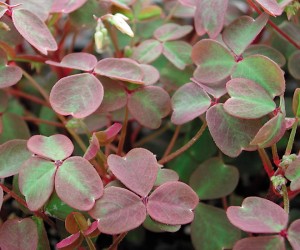When it comes to St. Patrick’s Day, shamrocks are rooted in tradition. However, what we call the shamrock in the U.S. is not the same as the shamrock of Ireland.
Here, the oxalis, or wood sorrel, plays the role of shamrock, which in Ireland, is the yellow-flowered clover or trefoil (Trifolium dubium). It’s tricky to grow this clover indoors, so nurseries and florists sell Oxalis plants instead for the holiday.
The shamrock became associated with the patron saint of Ireland because he supposedly plucked one from the ground to demonstrate the Holy Trinity of the Roman Catholic faith: the Father, Son and Holy Ghost. Besides good luck, the shamrock symbolizes rebirth, which is really what spring is all about.
The shamrock we see at the retailers this time of year is Oxalis acetosella, which has green, triangular leaves and white flowers.
Although this spring charmer is attractive and can be grown outdoors as a frost tender summer bulb, it has even more beautiful cousins, including some with large, purple triangular leaves with pretty pink or white flowers. Others have green leaves with purple centers. Some have golden leaves or reddish green ones. These accent plants are easy to grow and provide flowers and attractive foliage all summer long.
There are more than 300 oxalis species. They grow from a small bulb (called a tuber) outdoors in part sun to shade, once all danger of frost has passed. Full sun is a little too intense for this plant. Because the tubers would be killed by winter temperatures, I grow my oxalis in a clay bowl, which I move to the basement every fall after the first freeze. The bowl and tubers stay in the cool basement until about this time of year, when I bring the container upstairs to a bright window, light, water and a little liquid fertilizer. Every few years, I divide the tubers in spring and share them with friends or plant them in another container.
Oxalis also can be planted as a low-growing summer ground cover around the base of other plants in the ground or in a container, where it soft the pot’s edge. At night, oxalis leaves fold and collapse against their stems. When day breaks, the leaves open wide again. Oxalis needs good drainage.
Oxalis should be kept evenly moist, but not sopping wet. Although oxalis likes to be a little crowded in the pot, if it dries out quickly, the tubers should be divided. Apply a liquid fertilizer every two or three weeks during the growing season. Always read and follow the label directions of the product you select.
If you want to save oxalis year to year, be sure to dig tubers in the ground after the first frost. Tubers dug from the ground should be rinsed off, dried and stored in a cool, dry place. Or, if in a pot, move the tuber-filled container to place cool to keep the plants from blooming, but warm enough so they don’t freeze.
Oxalis also can be a houseplant; however, indoors, it goes dormant two or three times a year for about three months at a time. When it starts to go dormant, the foliage will die back. Stop watering or fertilizing the plants. When you see new growth, begin the water-fertilizer regimen. Indoors, place oxalis in a bright window, but out of direct sun.
Some garden centers carry oxalis already growing in nursery pots or as bare bulbs ready for planting. The widest selection will be found through Internet and mail-order retailers.


